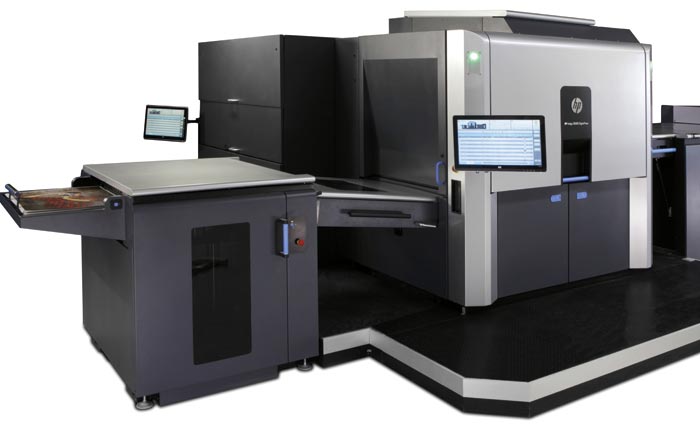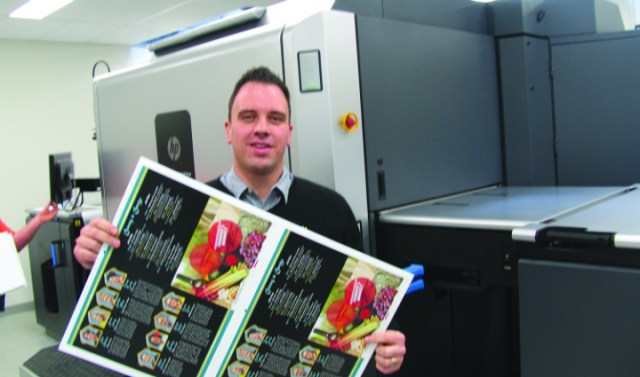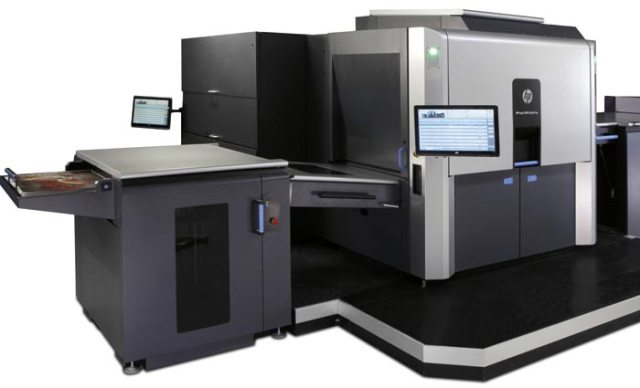
As a rule, at every Drupa there’s one machine that stands head and shoulders above the rest of the crowd. This year’s show was an exception – two technologies attracted particularly large throngs of punters. Benny Landa’s eagerly awaited nanography may have garnered more column inches than any other machinery on display, but few products attracted as many sales as HP’s new Indigo 10000 press. HP’s largest global print customer, Consolidated Graphics, signed up for a whopping 11 of the B2 beasts on the second day of the show, with the manufacturer claiming that it had doubled its sales target over the course of the show’s duration.
The strong showing in the Messe halls vindicated the hyperbole whipped up by HP in the wake of the launch of the new press, which was unveiled at HP’s pre-Drupa event in Tel Aviv in March. At the time, HP Indigo general manager Alon Bar-Shany claimed the new digital press would propel the Indigo into the heart of the offset market. His colleague, Francois Martin, HP Graphic Solutions Business worldwide marketing director, was equally bullish, adding that the 10000 was the “first quality B2 digital press on the market” and was set to “change the way people look at digital print”.
Winning ticket
The 10000’s sales performance to date suggests HPs confident projections have paid off. It’s easy to see why punters have been drawn to the machine, which took more than 400 engineers four years to develop. The press handles a 750x510mm sheet in landscape format, prints up to seven colours at a top speed of 3,450 sheets per hour and has a monthly duty cycle of 2 million A4 pages per month.
Impressive stuff, but the key to the new machine isn’t how fast it can go. It’s all about the quality of print it can produce, which HP claims is on a par with standard analogue commercial offset printing presses in the B2 format.
“The HP Indigo 10000 is the only commercial solution delivering offset-like print quality using liquid ink,” explains Gido Van Praag, vice president of HP Graphic Solutions Business for Asia Pacific and Japan. “This is owing to the application of HP Indigo known technology also in this format, which includes, for example, the application of the well-known offset principles of
a plate, blanket and impression cylinder construction. For relevant runs, the press is positioned as a flexible and economic alternative to standard analogue presses allowing printers to optimise service times and deliver against the needs of print buyers eg, printing without any makeready and waste.”
Fantastic five
While Van Praag says the 10000 has “many” different USPs, he singles out five particular areas that differentiate it from rival offerings. “The 10000 can print any size commercial job digitally; it has the highest productivity for a sheetfed digital press in the market; it can easily fit into the general commercial print shop; it has a high level of automation and ergonomics; and it offers greater flexibility of production – it can print anything on a large variety of media, with many colour options and many options for workflow including many third party solutions.”
In the current market, flexibility is a major plus point for printers, so the 10000’s advanced paper path system with multiple feeding trays, auto perfecting, multiple stacking options and ability to finish inline only add to its allure. The machine can also handle a wide range of different substrates, from 65-400gsm in weight to 75-450 microns in thickness. In addition, it can cope with thousands of different substrates encompassing coated, uncoated, textured, coloured and metallic substrates – to name but a few.
A further major draw of the 10000 is its ease of use thanks to those aforementioned high levels of automation, which are much higher than previous generations of HP machines, according to Van Praag.
“Consumable replacement for the blanket and PIP (photo imaging plate) are now automatic, also there is a lot of print quality automation, from closed loop, automated registration adjustment during print time, to calibrating colour using a spectrophotometer and an embedded scanner-vision system for automated calibrations and uniformity,” adds Van Praag.
The 10000 features Indigo’s PrintCare suite, which aids trouble-shooting, diagnosis and recovery and boasts remote support capabilities, reducing downtime. “HP is the first digital vendor to offer a fully remote support and problem diagnosis facility for its Indigo digital presses aimed at streamlining the fault finding and rectification process to increase uptime,” says Van Praag.
Such features are sure to go down well with the 10000’s wide target audience, which encompasses mid to large commercial printers, book printers, photo speciality shops, folding cartons printers, point-of-sale producers and DM houses.
The offset crowd
Van Praag says that the greatest level of interest in Australia and New Zealand has come from companies who already boast a B2 offset presence so can immediately take advantage of the format size, speed and throughput that the 10000 offers. That’s if they can lay their hands on one of course. First commercial shipments start in early 2013 in Australia, with HP Indigo Australian distributor Currie Group reporting a rising number of expressions of interest in the new press. Phillip Rennell, sales and marketing director at Currie Group, says: “There has been a strong interest from our customers in a larger-format HP Indigo press for some time so we were very pleased with the response we have had since HP announced the 10000. At Drupa, we saw commitments from customers that exceeded our expectations.”
And those of HP itself, according to Van Praag. “We received a large number of letters of intent (LOIs) at Drupa to buy the press during 2013. In fact, we received more than double our original targets for LOIs at the show.”
The price of the Indigo 10000 varies depending on the configuration and options chosen although a good ballpark figure is around the US$1.5 million mark, which is a pretty hefty price tag. But Van Praag is confident that the manufacturer can build on the existing Indigo install base in Australia in New Zealand. It’s difficult to draw a cost comparison with rival manufacturers as the machine doesn’t really have a direct digital rival – HP claims that first and foremost the 10000 competes with B2 offset presses so in that regard, the cost comparison would be more favourable.
In the digital B2 space, HP considers the Fujifilm Jetpress 720 and the Screen Truepress JetSX (see Alternatives box) to be the closest comparative products.
Manufacturers such as Konica Minolta, Ryobi-Miyakoshi and KBA are all expected to follow suit with their own B2 inkjet offering over the next few years, but HP has gained a significant first-mover advantage over rivals. Van Praag is confident that the 10000, alongside the revamped versions of the 5600 and the 7600 Indigo presses that also debuted at Drupa, puts the company in a strong position to cash in on the growing thirst for digital presses both locally and globally.
“We see accelerating demand for our range of sheetfed and roll fed products as the industry accepts digital printing as a rapidly growing area of the industry,” says Van Praag.
“Indigo is unique in its offset quality and this is an important difference for printers as it helps them meet the demands of their customers for offset quality while driving cost reductions through efficiency and enabling innovation through short runs, personalisation and variable data. As such, HP Indigo is the market leader in Australia and New Zealand for commercial digital offset printing presses with approximately 200 presses producing high value offset pages on a daily basis.”
The introduction of the 10000 looks set to see to this figure increase over the coming years.
SPECIFICATIONS
Max speed: 3,450 B2 sheets per hour
Duty cycle: 2 million B2 pages per month
Max resolution: 2,438×2,438dpi
Max sheet size: 75x53cm
Paper weight: 65-400gsm
Paper thickness: 75-450 microns
Price: On application
Contact: Currie Group, (03) 9810 1331, enquiries@curriegroup.com.au
Fujifilm’s first high-volume digital inkjet press made its debut at Drupa 2008 as a technology demo. The machine is capable of producing print quality on a par with an offset device, according to the manufacturer. At top speed, it can print up to 2,700 29.5×20.8-inch 4-up sheets per hour, or 10,800 8.5×11-inch pages per hour.
Max speed: 2,700 B2 sph
Max resolution: 1,200dpi with four variable dot sizes
Price: on application
Contact: Fujifilm Australia, (02) 9466 2600, www.fujifilm.com.au
Screen Truepress JetSX
The Truepress Jet SX, which is equipped to print fully variable data, is a full-colour press that is capable of handling a wide range of substrates, from inkjet and standard coated/uncoated offset papers through to boards of up to 0.6mm thickness, according to the manufacturer.
Max speed: 1,620 B2 sph
Max resolution: 1,440dpi
Price: on application
Contact: Screen Australia, 1300 305 118, www.screenaust.com.au
Comment below to have your say on this story.
If you have a news story or tip-off, get in touch at editorial@sprinter.com.au.
Sign up to the Sprinter newsletter


